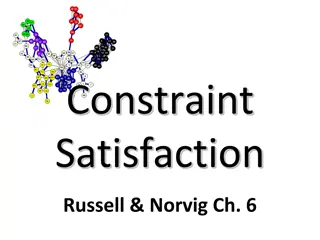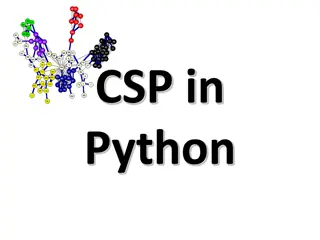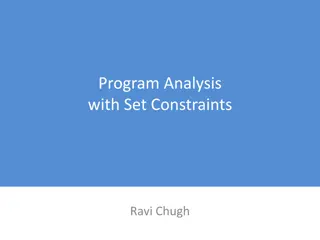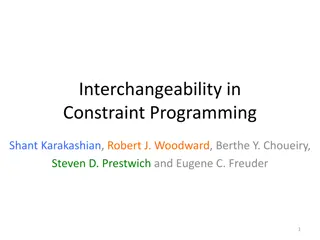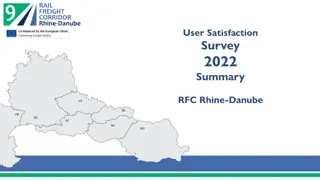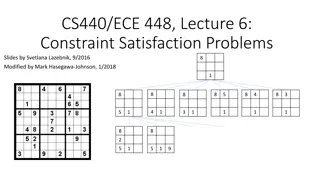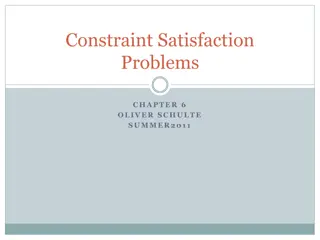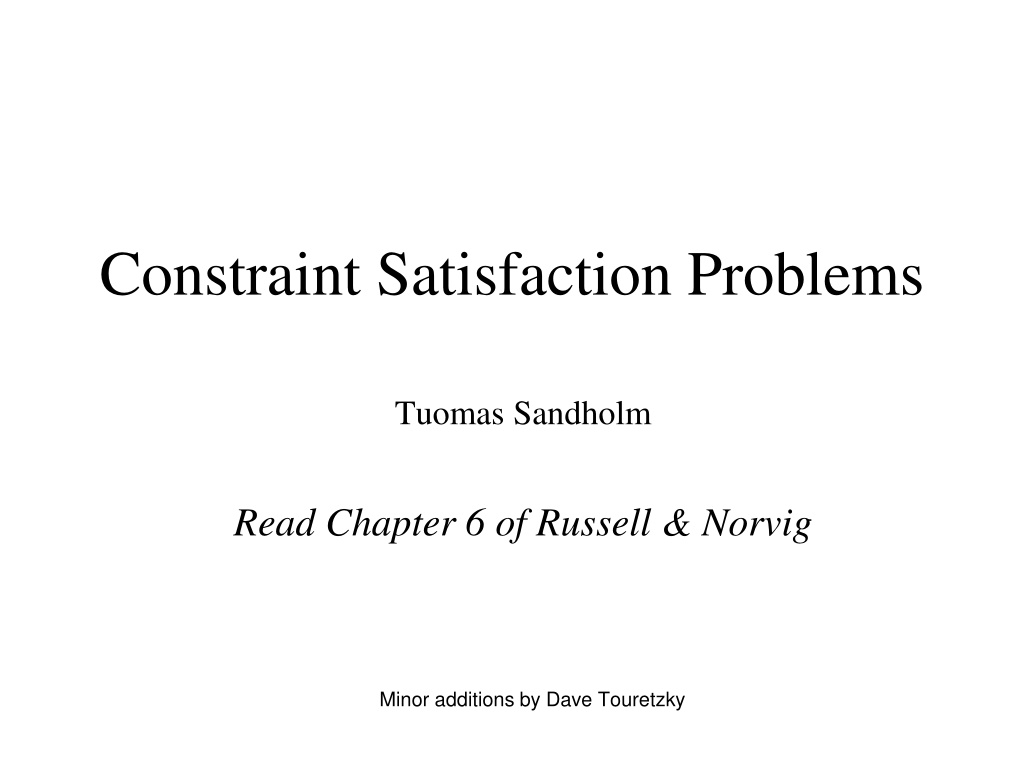
Understanding Constraint Satisfaction Problems in AI
Dive into the world of Constraint Satisfaction Problems (CSPs) as explained in Chapter 6 of Russell & Norvig's book with additional insights by Dave Touretzky. Explore how CSPs use formal representation languages to solve problems efficiently, illustrated with examples like map coloring and constraint graphs.
Download Presentation

Please find below an Image/Link to download the presentation.
The content on the website is provided AS IS for your information and personal use only. It may not be sold, licensed, or shared on other websites without obtaining consent from the author. If you encounter any issues during the download, it is possible that the publisher has removed the file from their server.
You are allowed to download the files provided on this website for personal or commercial use, subject to the condition that they are used lawfully. All files are the property of their respective owners.
The content on the website is provided AS IS for your information and personal use only. It may not be sold, licensed, or shared on other websites without obtaining consent from the author.
E N D
Presentation Transcript
Constraint Satisfaction Problems Tuomas Sandholm Read Chapter 6 of Russell & Norvig Minor additions by Dave Touretzky
Constraint satisfaction problems (CSPs) Standard search problem: state is a "black box any data structure that supports successor function and goal test CSP: state is defined by variables Xiwith values from domain Di goal test is a set of constraints specifying allowable combinations of values for subsets of variables Simple example of a formal representation language Allows useful general-purpose algorithms with more power than standard search algorithms 2
Example: Map-Coloring Variables WA, NT, Q, NSW, V, SA, T Domains Di= {red,green,blue} Constraints: adjacent regions must have different colors E.g.: WA NT, or (WA,NT) in {(red,green),(red,blue),(green,red),(green,blue),(blue,red),(blue,green)} 3
Example: Map-Coloring Solutions are complete and consistent assignments E.g., WA = red, NT = green, Q = red, NSW = green, V = red, SA = blue, T = green 4
Constraint graph Binary CSP: each constraint relates two variables Constraint graph: nodes are variables, arcs are constraints 5
Varieties of CSPs Discrete variables finite domains: n variables, domain size d O(dn) complete assignments E.g., Boolean CSPs, incl. Boolean satisfiability (NP-complete) infinite domains: integers, strings, etc. E.g., job scheduling, variables are start/end days for each job can t enumerate all possible assignments, so need a constraint language, e.g., StartJob1+ 5 StartJob3 Continuous variables E.g., start/end times for Hubble Space Telescope observations linear constraints solvable in polynomial time by linear programming (LP) 6
Varieties of constraints Unary constraints involve a single variable, e.g., SA green Binary constraints involve pairs of variables, e.g., SA WA Higher-order constraints involve 3 or more variables, e.g., cryptarithmetic column constraints global constraints such as Alldiff 7
Example: Cryptarithmetic Variables: F T U W R O C1C2 C3 Domains: {0,1,2,3,4,5,6,7,8,9} Constraints: Alldiff (F,T,U,W,R,O) O + O = R + 10 C1 C1+ W + W = U + 10 C2 C2+ T + T = O + 10 C3 C3= F T 0, F 0 8
Real-world CSPs Assignment problems e.g., who teaches what class Timetabling problems e.g., which class is offered when and where? Transportation scheduling Factory scheduling Notice that many real-world problems involve real-valued variables 9
Two Kinds of CSP Inference Steps 1. Search: pick some variables and assign values to them. Can use DFS. 2. Constraint propagation: use the values of some variables to reduce the set of possible values for other variables. Repeat until no further reductions are possible. 10
Backtracking Search Variable assignments are commutative, i.e., [ WA = red then NT = green ] same as [ NT = green then WA = red ] => Only need to consider assignments to a single variable at each node Depth-first search for CSPs with single-variable assignments is called backtracking search Can solve n-queens for n 25 11
Single variable assignments WA NT 15
Single variable assignments WA NT Q 16
Improving backtracking efficiency General-purpose methods can give huge gains in speed: Which variable should be assigned next? In what order should its values be tried? Can we detect inevitable failure early? 17
Question for the class The most constrained variable is the one with the fewest choices of values. In a depth-first search, would it be better to explore assignments to the most constrained or the least constrained variable next? 18
Most constrained variable heuristic Choose the variable with the fewest legal values a.k.a. minimum remaining values (MRV) heuristic 19
Most constraining variable heuristic (the degree heuristic) Choose the variable with the most constraints on remaining unassigned variables A good idea is to use it as a tie-breaker among most the constrained variables: 20
Least constraining value heuristic Given a variable to assign, choose the least constraining value: the one that rules out the fewest values in the remaining variables Combining these heuristics makes 1000 queens feasible 21
Forward checking Idea: Keep track of remaining legal values for unassigned variables Terminate search when any variable has no legal values 22
Forward checking Idea: Keep track of remaining legal values for unassigned variables Terminate search when any variable has no legal values 23
Forward checking Idea: Keep track of remaining legal values for unassigned variables Terminate search when any variable has no legal values 24
Forward checking Idea: Keep track of remaining legal values for unassigned variables Terminate search when any variable has no legal values 25
Forward checking isnt enough Forward checking propagates information from assigned to unassigned variables, but doesn't provide early detection for all failures: Assign green to Q. Then NT and SA cannot both be blue! Constraint propagation algorithms repeatedly enforce constraints locally 26
Arc consistency Simplest form of constraint propagation makes arcs consistent X Y is consistent iff for every value x of X there is some allowed y 27
Arc consistency Simplest form of constraint propagation makes arcs consistent X Y is consistent iff for every value x of X there is some allowed y 28
Arc consistency Simplest form of constraint propagation makes arcs consistent X Y is consistent iff for every value x of X there is some allowed y If X loses a value, neighbors of X need to be rechecked 29
Arc consistency Simplest form of constraint propagation makes arcs consistent X Y is consistent iff for every value x of X there is some allowed y If X loses a value, neighbors of X need to be rechecked Arc consistency detects failure earlier than forward checking Can be run as a preprocessor or after each assignment 30
Arc consistency algorithm AC-3 Time complexity: O(#constraints|domain|3) Checking consistency of an arc is O(|domain|2)31
k-consistency A CSP is k-consistent if, for any set of k-1 variables, and for any consistent assignment to those variables, a consistent value can always be assigned to any kth variable 1-consistency is node consistency 2-consistency is arc consistency For binary constraint networks, 3-consistency is the same as path consistency Getting k-consistency requires time and space exponential in k Strong k-consistency means k -consistency for all k from 1 to k Once strong k-consistency for k=#variables has been obtained, solution can be constructed trivially Example that is 3-consistent but not 2-consistent: {R} {R,B} {R} Tradeoff between propagation and branching Practitioners usually use strong 2-consistency and less commonly 3-consistency 32
Other techniques for CSPs Global constraints E.g., Alldiff Bipartite graph with variables on one side, values on the other; only edges that belong to some matching that matches all variables (can be determined in polytime) can belong to a valid assignment E.g., Atmost(10,P1,P2,P3), i.e., sum of the 3 vars 10 Special propagation algorithms Bounds propagation E.g., number of people on two flights: D1 = [0, 165] and D2 = [0, 385] Constraint that the total number of people has to be at least 420 Propagating bounds constraints yields D1 = [35, 165] and D2 = [255, 385] Symmetry breaking 33
Nearly tree-structured CSPs (Finding the minimum cutset is NP-complete.) 37
Tree decomposition Every variable in original problem must appear in at least one meganode If two variables are connected in the original problem, they must appear together (along with the constraint) in at least one meganode If a variable occurs in two meganodes in the tree, it must appear in every meganode on the path that connects the two The only constraints between the meganodes are that the variables take on the same values across meganodes Algorithm: solve for all solutions of each meganode. Then, use the tree- structured algorithm, treating the meganodes as variables O(ndw+1) where w is the treewidth (= one less than size of largest meganode) E.g., treewidth of a tree is 1 Finding a tree decomposition of smallest treewidth is NP-complete, but good heuristic methods exist 38
Local search for CSPs Hill-climbing, simulated annealing typically work with "complete" states, i.e., all variables assigned To apply to CSPs: allow states with unsatisfied constraints operators reassign variable values Variable selection: randomly select any conflicted variable Value selection by min-conflicts heuristic: choose value that violates the fewest constraints i.e., hill-climb with h(n) = total number of violated constraints 39
Example: 4-Queens States: 4 queens in 4 columns (44= 256 states) Actions: move queen in column Goal test: no attacks Evaluation: h(n) = number of attacks Given random initial state, can solve n-queens in almost constant time for arbitrary n with high probability (e.g., n = 10,000,000) 40
Summary CSPs are a special kind of problem: states defined by values of a fixed set of variables goal test defined by constraints on variable values Backtracking = depth-first search with one variable assigned per node Variable ordering and value selection heuristics help significantly Forward checking prevents assignments that guarantee later failure Constraint propagation (e.g., arc consistency) does additional work to constrain values and detect inconsistencies Iterative min-conflicts is usually effective in practice 41
Additional Slides (not included in this lecture) 42
Interlude Does the n-queens problem become easier or harder if some of the queens locations are already given and cannot be changed? 43
Summary of the complexity of the n-queens problem The decision problem is solvable in constant time since there is a solution for all n > 3. A witnessing solution can be constructed easily [Bell & Stevens, 2009] but note that the witness (a set of n queens) requires n log n bits to specify but this is not polynomial in the size of the input, which is only log n bits. (The problem has often been incorrectly called NP-hard.) If some of the queens are already in fixed locations, the problem is NP-complete and #P-complete. End of interlude 45
Advanced topic: State of knowledge on treewidth algorithms Determining whether treewidth of a given graph is at most k is NP-complete In what follows, n is the number of vertices O(sqrt(log n)) approximation of treewidth in polytime [Feige, Hajiaghayi and Lee 2008] O(log k) approximation of treewidth in polytime [Amir 2002, Feige, Hajiaghayi and Lee 2008] When k is any fixed constant, the graphs with treewidth k can be recognized, and a width k tree decomposition can be constructed for them, in linear time [Bodlaender 1996] I.e., only exponential in a (large) polynomial of k There is an algorithm that approximates the treewidth of a graph by a constant factor of 3.66, but it takes time that is exponential in the treewidth [Amir 2002] Open question: Polynomial-time approximation scheme (PTAS) 46

